What is a hip fracture?
A hip fracture is more than a broken bone. If you are older, breaking your hip can mean a major change in your life. You will probably need surgery, and it can take as long as a year to recover. But activity and physical therapy can help you get your strength and mobility back.
Most people break their hip near the upper part of the thighbone (femur). It usually happens near where the thighbone fits into the hip joint or at the junction of the neck & the shaft of the femur.
What are the symptoms of a hip fracture?
If your hip is broken, you will most likely:
-
Have severe pain in your hip or lower groin area.
-
Not be able to walk or put any weight on your leg.
These symptoms are most common after a fall. But if you have very thin bones from osteoporosis or another problem, you could break your hip without falling.
In rare cases, people have only thigh or knee pain. They may be able to walk.
What causes hip fractures?
Most hip fractures happen to people who are 65 or older, and they are usually caused by falls. As you get older, your bones naturally lose some strength and are more likely to break, even from a minor fall. Children and young adults are more likely to break a hip because of a bike or car accident or a sports injury.
Other things that increase your risk of breaking your hip include:
-
Being female.
-
Your family history—being thin or tall or having family members who had fractures later in life.
-
Not getting enough calcium and vitamin D, which you need for strong bones.
-
Not being active. Weight-bearing exercise, such as walking, helps keep bones strong.
-
Smoking.
-
Medical conditions that cause dizziness or problems with balance, or conditions such as arthritis that can interfere with steady and safe movement.
-
Taking certain medicines, such as long-term steroid medicines used to treat asthma or COPD.
Understanding Hips and Hip Fractures
To further understand how hip fractures happens it is best to understand how the hip works. The hip joint is one of the true ball-and-socket joints of the body. The hip socket is called the acetabulum and forms a deep cup that surrounds the ball of the upper thighbone, or femoral head. The femoral head is attached to the rest of the femur by a short section of bone called the femoral neck. The bump on the outside of the femur just below the femoral neck is called the greater trochanter. This is where the large muscles of the buttock attach to the femur.
A Healthy hip
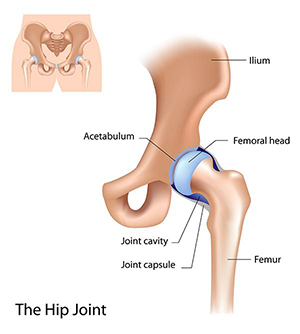
What Are the Different Types of Hip Fracture?
A fracture is a partial or complete break in a bone. There can be either a single break or multiple breaks in a bone. A hip fracture is classified by the specific area of the break and the type of break in the bone.
The most common types of hip fractures are:
-
Femoral neck fracture: A femoral neck fracture occurs one to two inches from the hip joint. These fractures are common among older adults and can be related to osteoporosis. This type of fracture may cause a complication because the break usually cuts off the blood supply to the head of the femur which forms the hip joint.
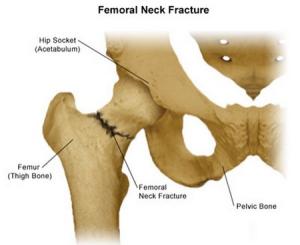
-
Intertrochanteric hip fracture: An intertrochanteric hip fracture occurs three to four inches from the hip joint. This type of fracture does not interrupt the blood supply to the bone and may be easier to repair.
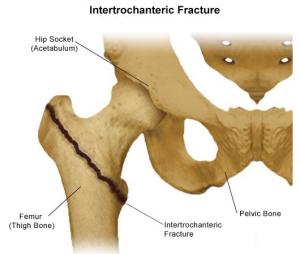
Around 90 percent of hip fractures fall into these two categories in relatively equal numbers. Another type of fracture called a stress fracture of the hip may be harder to diagnose. This is a hairline crack in the femur that may not involve the whole bone. Overuse and repetitive motion can cause a stress fracture. The symptoms of this injury may mimic those of tendonitis or muscle strain.
How is a hip fracture diagnosed?
Doctors use X-rays to diagnose a broken hip. You may need another test if your doctor thinks that you have a fracture but can't see it on an X-ray. You might have a test such as:
-
An MRI, which gives better images of bones and soft tissues.
-
A CT scan, another way of getting more detailed images.
Xray Femoral Neck Fracture
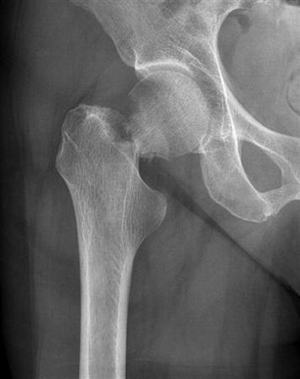
Xray Intertrochanteric Fracture
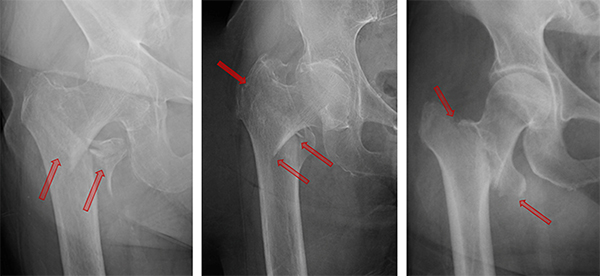
How is a hip fracture treated?
You will most likely need surgery to fix your hip. Surgery usually works well, but your hip will probably take a long time to get better.
Surgery is done as soon as possible after a hip fracture is diagnosed, often within 24-48 hours. Having surgery right away may help shorten your stay in the hospital and reduce pain and complications. Sometimes surgery is delayed for 1 to 2 days so other medical problems can be treated first.
The type of surgery you have will depend on where the break is and how bad it is.
-
Hip repair surgery is called internal fixation. The surgeon uses metal screws(hip pinning), rods, or plates to hold the bone together while it heals. This surgery is usually chosen if the bones can be lined up properly. Age and the degree of displacement of the fracture play a role in treatment decision.
-
Hip replacement surgery involves replacing part or all of the joint with artificial parts. In a partial hip replacement, the doctor replaces the broken upper part of the thighbone. In a total hip replacement, both the hip socket and the top of the thigh bone are replaced. Total hip replacement is often done when the fractured bone strength is very poor. Hip replacement often times allow the patient to immediately start walking on the hip which reduces postoperative complications.
Treatments of femoral neck fractures
Hip pinning aka CRPP
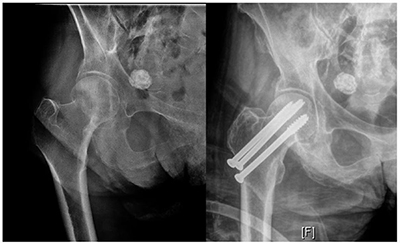
Partial Replacement (hemiarthroplasty)
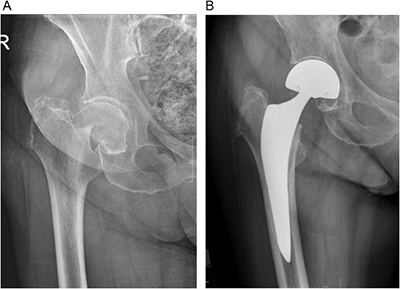
Total Hip Arthroplasty
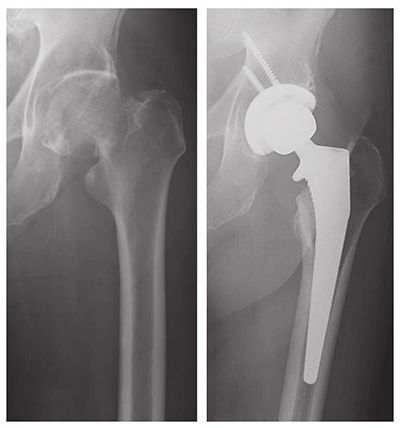
After surgery, your doctor will want you to start moving as soon as you can. This will help prevent problems such as pneumonia, blood clots, and bed sores. These things may happen because you have to stay in bed so long. You may also need to take a blood-thinning medicine to reduce the risk of blood clots.
After your surgery, it will be hard to do things like cooking and getting dressed by yourself. So for a while you may need to stay in a rehabilitation (rehab) center.
Your doctor will encourage you to take part in a rehab program that includes physical therapy and occupational therapy. This will teach you:
-
Exercises to help you regain your strength and ability to move around.
-
New ways to do simple daily activities.
-
Safe ways to stay active.
Taking part in a rehab program is very important because it will speed up your recovery and help you to get back to your normal activities sooner.
After a hip fracture, some people aren't EVER able to get around as well as they could before. They may need to use a walker or cane. They may need help with daily activities such as dressing and bathing. And many can no longer live on their own. Work hard to get your strength and mobility back so you can be as independent as possible. Hip fractures are extremely tough to get over. In fact, elderly patients have a 20-30% risk of dying within 1 year of the hip fracture. This is not so much from the surgery as it is from the difficult recovery making them prone to blood clots, pneumonias, urinary tract infections, etc...
I hope you find this information helpful and thank you for trusting me with your care!
Dr. Colten Luedke
